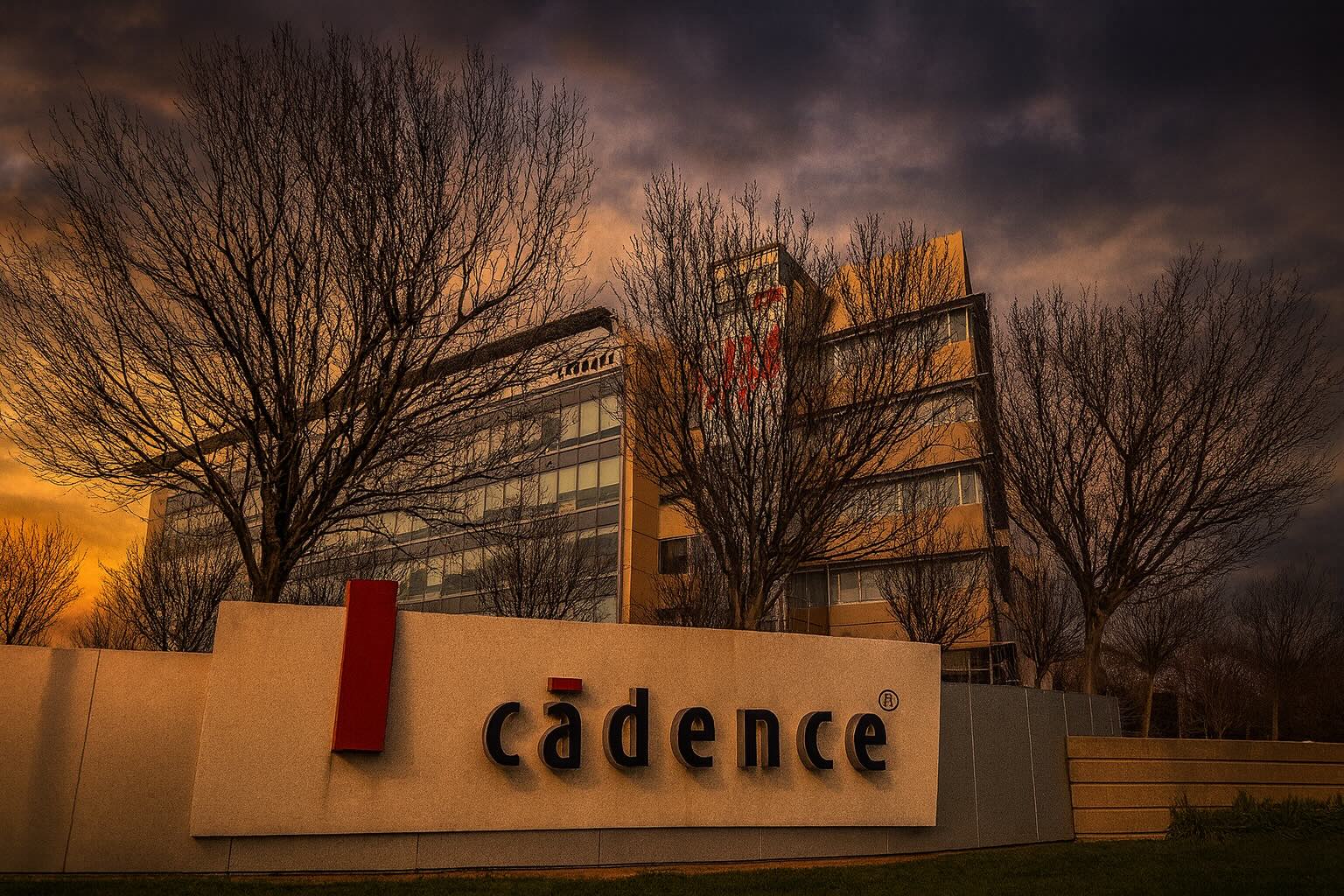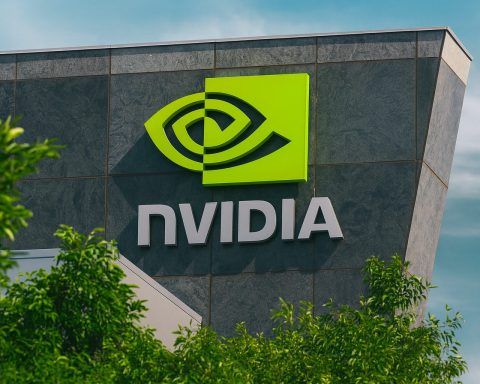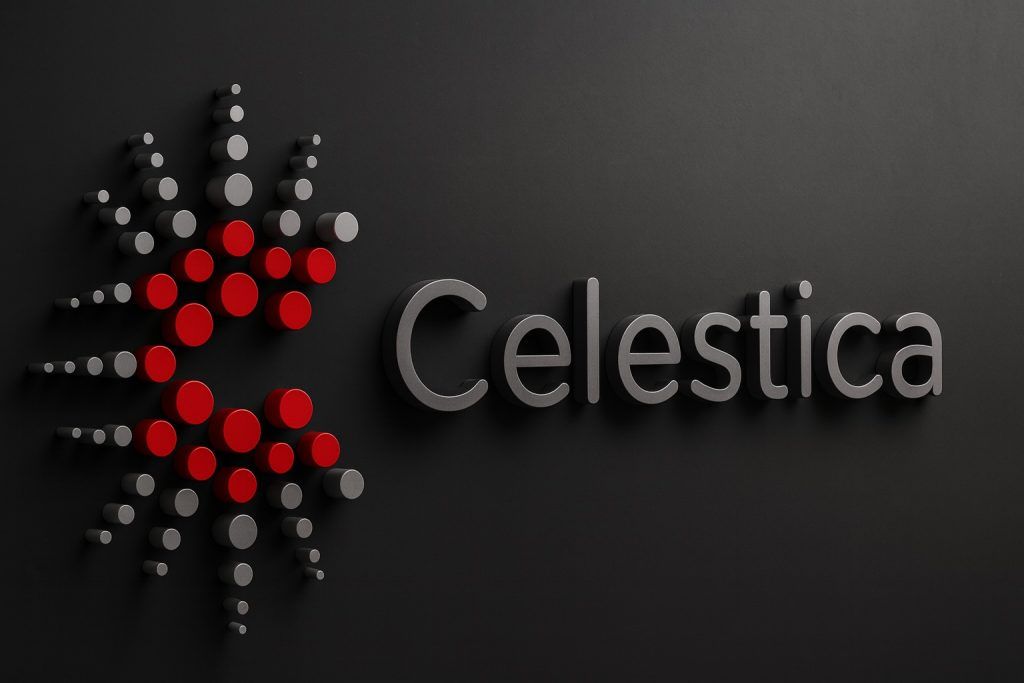- Q3 earnings beat expectations: Cadence Design Systems reported adjusted Q3 EPS of $1.93 (vs. $1.79 expected) on revenue of $1.34 billion (vs. $1.32 billion expected), up ~10% year-over-year [1]. GAAP net income was $287 million ($1.05/share), rising from $238 million ($0.87) a year ago [2].
- Raised full-year outlook: Buoyed by strong demand, Cadence hiked its FY2025 guidance – revenue is now seen at $5.26–$5.29 billion (~14% YoY growth) [3], and full-year non-GAAP earnings at $7.02–$7.08 per share (above the ~$6.93 consensus) [4]. (On a GAAP basis, EPS guidance was trimmed to $3.80–$3.86, reflecting acquisition-related costs [5] [6].)
- Stock steady near highs: CDNS stock closed around $349 (~+16% YTD) ahead of results and dipped only ~0.5% in after-hours trading despite the beat [7]. Shares are hovering near their all-time high of $376 [8], as investors weigh rich valuations against robust growth.
- Record backlog & AI tailwinds: Cadence’s order backlog hit a record $7.0 billion (with $3.5 B expected as revenue over the next 12 months) [9], underscoring strong AI-driven demand. CEO Anirudh Devgan noted “deepening strategic relationships across the AI ecosystem” positioning Cadence as a “trusted partner to deliver AI-centric transformational solutions” [10].
- Big acquisitions expand reach: In Q3 Cadence completed its purchase of Arm’s “Artisan” chip IP business and agreed to buy Hexagon’s Design & Engineering unit for ~$3.2 billion [11]. The Hexagon deal (closing in early 2026) extends Cadence beyond chips into industrial simulation, adding customers like BMW, Lockheed Martin and Volkswagen [12] [13].
- Analysts bullish but mindful: Wall Street consensus on CDNS is a “Moderate Buy” – 13 Buys vs. 3 Holds – with an average price target around $370 [14] (~5% above current levels). Several brokers recently hiked targets (KeyCorp to $405, Loop Capital to $390) after Cadence’s strong Q2 and upbeat outlook [15]. However, at ~88× earnings, Cadence’s valuation far exceeds industry norms [16], prompting debate over how much future AI growth is already priced in.
- Semiconductor boom backdrop: The chip industry’s upswing is lifting EDA software leaders like Cadence. Global semiconductor sales hit $626 billion in 2024 (↑18% YoY) and are projected to reach ~$705 billion in 2025 amid surging demand for AI processors [17]. Generative AI is now the second-largest chip market and is speeding up chip development cycles – even EDA vendors are using AI to optimize circuit design [18]. This “AI super-cycle” is a key tailwind behind Cadence’s growth story.
Q3 Earnings Beat Expectations
Cadence Design Systems delivered better-than-expected third-quarter results, showcasing resilient growth as the semiconductor design boom continues. Adjusted EPS jumped to $1.93, topping analyst forecasts of $1.79 [19]. Revenue for Q3 hit $1.34 billion, edging past the $1.32 B consensus and rising ~10% from $1.22 B in the year-ago quarter [20]. On a GAAP basis, net income was $287.1 million ($1.05 per share), up ~20% year-on-year [21] – reflecting solid operational gains even after accounting for acquisition costs. The company cited broad-based strength across its product lines (which span chip design software, IP, and hardware systems), as customers accelerated projects in areas like artificial intelligence (AI) and high-performance computing.
Notably, Cadence’s operating profitability continues to improve. The firm’s non-GAAP operating margin reached 47.6% in Q3, up from 44.8% a year ago, thanks to robust revenue growth and scalability in its software-centric business [22]. This helped Cadence extend its streak of earnings surprises. In fact, Q3 marked another quarter of double-digit revenue growth – albeit at a moderated pace versus Q2’s 20% surge – underscoring sustained demand even as year-ago comparisons get tougher. According to CFO John Wall, backlog levels hit an all-time high, providing excellent visibility. The order backlog topped $7.0 billion as of quarter-end (with roughly half expected to convert to revenue over the next year) [23]. This massive backlog “puts us on track to deliver a strong 2025,” Wall noted, highlighting the breadth of customer commitments across all business segments [24].
Market reaction to the solid results was muted but generally positive. Cadence’s stock (NASDAQ: CDNS) rose about 1.1% on October 27 ahead of the earnings release, closing near $349 – and up roughly 16% year-to-date, handily outperforming the broader Nasdaq. In after-hours trading, CDNS initially dipped ~0.5% to about $347.5 [25]. Traders appeared to be factoring in the company’s slightly conservative GAAP profit outlook (more on that below) and the stock’s elevated valuation, in addition to the strong quarterly beat. Overall, investors saw no red flags in the quarter – Cadence’s growth engine remains intact, supported by secular trends in chip design activity. The stock continues to trade not far from its 52-week high of $376.45 [26], as optimism around Cadence’s role in the AI silicon boom keeps sentiment bullish.
AI Boom Powers Growth & Guidance Uplift
Cadence credits much of its current momentum to the exploding demand for AI and specialized semiconductor design – a trend that has become a rising tide for the entire electronic design automation (EDA) industry. “Cadence delivered excellent results for the third quarter of 2025,” said CEO Anirudh Devgan, noting the company’s “record backlog and ongoing broad-based strength” across its businesses [27]. Management highlighted particularly strong uptake of Cadence’s cutting-edge tools for AI chip design, system verification, and cloud-based EDA workflows. As Devgan put it, “With deepening strategic relationships across the AI ecosystem, Cadence is uniquely positioned to be the trusted partner to deliver AI-centric transformational solutions.” [28] In other words, as dozens of companies race to build next-generation AI accelerators, smart sensors, and advanced processors, Cadence’s software and IP are often mission-critical in helping those chips get designed and optimized quickly.
This AI-driven tailwind is evident in Cadence’s updated outlook. Buoyed by strong year-to-date performance and a favorable demand environment, the company raised its full-year 2025 forecast on October 27. Cadence now expects FY2025 revenue of $5.26–$5.29 billion (up ~14% year-on-year) [29], slightly above Wall Street’s prior consensus (~$5.25 B). It also lifted its full-year adjusted EPS guidance to $7.02–$7.08 (from a prior ~$6.90 midpoint), which exceeds the ~$6.93 average analyst estimate [30]. The improved outlook reflects broad demand strength “across all our businesses” according to CFO Wall, who pointed out that even after the recent growth, the company’s backlog covers a significant portion of next year’s plan [31].
Interestingly, on a GAAP basis Cadence actually trimmed its EPS outlook to $3.80–$3.86 (from ~$4.00 previously) [32] [33]. The reduction is due to near-term impacts from acquisitions and one-time charges (which affect GAAP earnings). But underlying operating guidance is stronger than ever – hence the bump in non-GAAP profit forecast. Cadence’s management emphasized that the slight GAAP downgrade is largely accounting noise; the core business fundamentals remain very robust. In fact, the CEO and CFO both struck optimistic tones about demand into next year. John Wall (CFO) noted “broad-based momentum across all our businesses” in Q3 and expressed confidence that Cadence is on track for a record 2025, given the company’s execution and pipeline [34].
Cadence’s optimism is backed by the broader market context. The global semiconductor industry is in the midst of a major upcycle fueled by AI, 5G, and electrification trends. After a cyclical dip in 2022, worldwide chip sales rebounded to $626 billion in 2024 (an 18% jump) and are projected to reach about $705 billion in 2025 [35]. Generative AI and data-center accelerators have become the fastest-growing segment – with data-center AI chip revenues doubling from 2023 to $112 billion in 2024 [36]. This spending surge is expected to continue into 2025. Chipmakers are pouring resources into ever more complex designs (GPUs, AI ASICs, advanced SoCs), which in turn boosts demand for Cadence’s EDA software, IP blocks, and verification hardware. Moreover, companies developing these chips are increasingly leveraging AI within the design process itself. Major EDA vendors like Cadence have introduced generative AI features (such as the Cadence Cerebrus platform and other ML-assisted tools) to automatically optimize circuit layouts and testing, cutting design cycles for customers [37] [38]. In short, AI is both the product and the process – driving new chip innovations and helping to create them. This virtuous cycle has provided Cadence with multi-year growth tailwinds. As Devgan noted, Cadence’s deep ties across the AI industry – from cloud data-center leaders to chip startups – put it in a sweet spot to capitalize on the “AI super-cycle.”
Strategic Moves: Cadence Expands Its Empire
Cadence isn’t relying on organic growth alone – it’s also been making bold strategic acquisitions to broaden its technology portfolio and address new markets. During Q3, Cadence completed the purchase of Arm’s “Artisan” physical IP business, a library of foundational chip design blocks widely used in semiconductor development [39]. This deal, announced earlier, brings in-house a key source of chip intellectual property (used for constructing system-on-chip designs), potentially opening new licensing revenue streams and tighter integration with Arm-based chip design flows. The move underscores Cadence’s aim to offer more complete end-to-end solutions for chipmakers – from front-end design software to ready-made IP components.
Even more eye-opening was Cadence’s agreement to acquire Hexagon AB’s Design & Engineering (D&E) software division for €2.7 billion (~$3.16 billion) [40]. Announced in late September, this is one of Cadence’s largest acquisitions ever and is set to close by Q1 2026 [41]. Hexagon’s D&E unit (which includes the well-known MSC Software suite) specializes in computer-aided engineering (CAE) – specifically, tools for structural simulation, stress analysis, and multi-body dynamics used heavily in automotive and aerospace design [42]. In plain terms, these are programs to virtually test how a car or airplane component holds up under force, heat, vibration, etc. By absorbing Hexagon’s CAE portfolio, Cadence will extend its reach beyond electronic circuits into the mechanical realm, making it a more comprehensive provider of engineering software. Crucially, the deal brings a new customer base: major automakers and aerospace firms (like Volkswagen, BMW, and Lockheed Martin) that currently use Hexagon’s tools [43]. Post-acquisition, Cadence can cross-sell its electronic design tools to those clients while offering its semiconductor customers new solutions for system-level simulation (think chip-package-board-vehicle co-design). The company noted this will help serve the growing need for “chip-to-system” design insights – for example, designing chips in tandem with the cars or aircraft they’ll be embedded in.
Cadence’s management has framed the Hexagon D&E acquisition as a natural extension of its strategy. It builds on Cadence’s prior foray into system analysis – notably the 2024 purchase of NUMECA and Pointwise (computational fluid dynamics tools) and $1.24 billion acquisition of BETA CAE Systems (a specialist in automotive/aerospace simulation) [44]. Together, these moves signal Cadence’s ambition to evolve from an EDA pure-play into a broader “intelligent system design” platform, covering chips, packages, PCBs, and now mechanical systems. This mirrors an industry trend: EDA and CAE are converging as electronics and software become ever more entwined with physical products. Notably, competitor Synopsys made a similarly dramatic move by acquiring ANSYS, Inc., the leader in physics-based simulation, in mid-2025. Synopsys closed the Ansys deal on July 17, 2025 [45] [46], calling Q3 a “transformational quarter” that expanded its portfolio and customer base significantly. With Ansys now under its wing, Synopsys projected full-year 2025 revenue of ~$7.04 billion [47], far larger than Cadence’s ~$5.28 billion – highlighting Synopsys’s increased scale advantage. However, Cadence’s Hexagon deal shows it won’t be left behind. Analysts say the acquisition spree by Cadence and Synopsys reflects an “arms race” to offer comprehensive multi-physics design platforms, as both strive to be the one-stop partner for customers designing the AI-enabled products of the future.
Of course, such large acquisitions come at a cost. Cadence will fund ~70% of the Hexagon D&E purchase in cash and 30% in stock [48], drawing down some of its hefty cash reserves and issuing shares to Hexagon AB. This could introduce near-term dilution and higher expenses (interest on any debt used, integration costs, etc.), which is likely why Cadence’s GAAP EPS guidance dipped. Nonetheless, the strategic rationale was well received – investors see the long-term growth potential from entering new verticals. If executed well, these deals could accelerate Cadence’s revenue growth in 2026 and beyond by tapping into automotive, aerospace, and industrial markets that are increasingly electronics-driven (think electric vehicles, autonomous systems, space tech). Cadence’s management emphasized the synergy in combining EDA and CAE: as products like EVs or drones become “computers on wheels/wings”, the line between chip design and system design is blurring. By having both capabilities, Cadence aims to enable customers to simulate entire systems (chips + physics) for optimal performance. This could give Cadence a differentiated edge against Synopsys (which has Ansys for similar ends) and other rivals in the years ahead.
CDNS Stock Performance: High Expectations, High Valuation
Cadence’s stock has been on a strong run, powered by its financial performance and the market’s enthusiasm for anything related to AI. Year-to-date, CDNS has gained roughly 15–20% (versus about mid-teens gains for the S&P 500), and over the past 12 months the stock returned ~26% including dividends [49]. Shares hit an all-time high around $376 in mid-2025 amid the peak of the AI frenzy, and after a late-summer pullback, have climbed back into the $340s–$350s range heading into the Q3 report [50]. At a market capitalization near $90+ billion, Cadence is now one of the world’s most valuable software companies – a reflection of investor confidence in its growth story and competitive moat in EDA tools.
The Q3 results did little to change the overall trajectory. With the modest post-earnings dip, CDNS remains not far from record levels. Some traders may have been taking profits or reacting to the GAAP EPS guidance cut, but the lack of a major selloff suggests that the earnings beat and raised outlook largely met the market’s high expectations. Market sentiment toward Cadence remains broadly positive, though increasingly bifurcated on valuation. On one hand, Cadence is delivering strong growth in a niche (EDA) that has high barriers to entry – the company consistently grows revenues double-digits and boasts operating margins near 30% (GAAP) and ~45% (non-GAAP), with secular tailwinds at its back. Bulls argue that Cadence deserves a premium for its dominant market position (shared with Synopsys) in the “picks and shovels” of the chip boom. On the other hand, by traditional metrics CDNS stock looks expensive: it currently trades around 88× trailing earnings and over 20× sales, multiples that assume years of high growth ahead [51]. For context, the average P/E in the software industry is ~35×, and even other high-flying chip software peers average ~64× [52]. This means Cadence is valued well above its peers – essentially “priced for perfection.” Any stumble in execution, slowdown in tech spending, or broader market correction could hit such a richly valued stock hard.
Some analysts have begun to voice caution on this front. Simply Wall St, in an October 18 analysis, noted that Cadence’s P/E ratio (near 88) “stands well above the US software industry average”, and that even using optimistic growth assumptions, a more justified fair multiple might be around 42× earnings [53]. They warn that persistent export restrictions (if the U.S. further limits EDA tool sales to China) or any unexpected weakness in AI hardware demand could quickly challenge the bullish outlook for Cadence [54]. Indeed, geopolitical risks linger in the background – Cadence and Synopsys have had to navigate U.S.-China trade tensions, with certain advanced chip design software now restricted for Chinese customers. So far this hasn’t materially derailed growth, but it remains a watch item.
Despite valuation concerns, institutional investors continue to be net buyers of Cadence. As of the latest filings, about 84.9% of CDNS shares are held by institutions [55], indicating strong confidence from pension funds, mutual funds, and other “smart money”. In fact, just last week an SEC filing revealed that hedge fund AlphaQuest LLC boosted its stake by 198% during Q2 [56], and other asset managers (including Saudi Central Bank and several investment firms) initiated or increased positions earlier this year [57]. This suggests that many professional investors see Cadence as a core long-term holding to ride the growth of the semiconductor and AI revolution, even if they acknowledge the rich valuation.
Street View: Expert Commentary and Outlook
Wall Street analysts, for the most part, remain upbeat on Cadence’s prospects. The consensus rating is a “Moderate Buy”, and many analysts have been raising their price targets throughout 2025 as Cadence consistently outperforms. According to MarketBeat data, 13 analysts rate CDNS a Buy, 3 have it at Hold, and only 1 at Sell, with a consensus target of about $369.70 [58]. That target implies modest upside (mid-single-digit percentage) from current levels – perhaps reflecting that the stock’s big run-up has closed the gap on a lot of price objectives. However, there are some notably bullish outliers: for instance, KeyBanc recently lifted its target to $405 (from $358) and reiterated an Overweight stance [59], citing Cadence’s accelerating growth and opportunities in AI silicon design. Loop Capital likewise bumped its target to $390 and maintained a Buy [60] after Cadence’s summer earnings showed robust momentum. Analysts at Needham and Robert W. Baird also upgraded targets into the high-$300s range around late July, following Cadence’s strong Q2 report and its upbeat guidance for Q3 and beyond [61]. These bullish analysts point to Cadence’s record of execution, the expanding total addressable market (with moves into system simulation and AI-driven design tools), and the company’s ability to consistently innovate (e.g. applying AI/ML to EDA) as reasons the stock can justify a premium valuation. In their view, Cadence is at the forefront of an AI-fueled “multi-year upgrade cycle” in chip design, which could drive earnings above Street forecasts in coming years.
To illustrate the growth narrative, one research commentary highlighted how Cadence’s investments in AI-driven design software are paying off: “Cadence’s strategic investments in AI-driven design and verification tools are expected to drive future revenue growth, as the company reports increasing adoption of its AI-enabled offerings, such as the Cadence Cerebrus AI solution and SimAI, which have shown significant performance improvements for customers.” [62] In other words, Cadence is not just riding the AI wave passively – it’s actively leveraging AI to make its own products more powerful, creating a virtuous cycle of improvement that keeps customers closely tied to its platform. This dynamic is key to maintaining its competitive edge over time.
At the same time, prudent voices urge some caution. Even among bullish analysts, there is acknowledgment that Cadence’s stock price leaves little room for error. As Simply Wall St noted, any hiccup in AI or cloud spending could temper growth expectations and put pressure on the share price [63]. Weaker demand from a major segment (say, a pause in hyperscaler data-center investments or delays in a few big chip design projects) could slow Cadence’s bookings. Additionally, integration risks around acquisitions like the Hexagon D&E deal bear watching – Cadence will need to smoothly blend a large new business with 1,100 employees in a different domain (mechanical simulation) [64] [65]. Executing that well is crucial to realizing the promised revenue synergies by 2026. There’s also the broader market factor: as long as interest rates remain high, high-multiple tech stocks can be more volatile. Some investors might rotate out of richly-valued names like Cadence into safer plays if macroeconomic conditions shift.
Market sentiment, however, seems to favor the bullish thesis for now. The buzz in the investor community is that Cadence is a picks-and-shovels winner of the AI age – a relatively under-the-radar cornerstone that enables marquee names like Nvidia, AMD, Apple, and others to create their cutting-edge chips. As one options strategy highlighted on TechStock², even those hesitant to chase the stock at ~$330+ have looked for ways to buy on dips. For instance, selling long-dated put options at lower strike prices can earn premium income and potentially snag Cadence shares at an effective cost basis around $220 (if the stock were to drop) [66]. The fact that some investors are employing such strategies suggests a belief that downside is limited and that Cadence’s long-term trajectory remains positive. In essence, there is confidence that any significant pullback in CDNS would attract buyers given the company’s fundamentals.
Looking ahead, Cadence’s financial forecasts and commentary project confidence in sustained growth. The company’s raised outlook for 2025 (mid-teens revenue growth, high-teens non-GAAP EPS growth) sets a strong baseline. Beyond that, if the semiconductor cycle and AI boom continue, Cadence could carry its momentum into 2026. Many analysts are already penciling in double-digit growth next year as well, with the Hexagon acquisition adding a few points of incremental revenue upon closing. Longer term, the secular drivers – proliferation of AI chips, increasing chip complexity (3nm and 2nm nodes, chiplet architectures, etc.), and new electronics in vehicles, IoT and cloud – all bode well for continued high demand for design tools. Industry projections envision the overall chip market approaching $1 trillion by 2030 [67], which implies a lot of design work to be done between now and then. As one of the two giants in EDA, Cadence is favorably positioned to capture a sizable share of that workload.
Bottom Line: Cadence Design Systems is firing on all cylinders. The Q3 results reinforced that the company is benefiting handsomely from the current chip renaissance, especially the AI and high-performance computing wave. Management’s upbeat guidance hike and commentary about record backlog reflect confidence in the pipeline. Cadence is also aggressively investing for the future – expanding into adjacent domains like system simulation – to ensure it can offer comprehensive solutions as chips and systems converge. While the stock’s valuation is undeniably steep and warrants caution, the market’s verdict so far is that Cadence’s growth story justifies the premium. With analysts largely in agreement about its bright prospects (even if some urge moderation on the price), CDNS remains a market darling in the chip software space. Investors will be watching upcoming quarters for continued execution, successful integration of acquisitions, and evidence that AI-driven demand remains robust. For now, Cadence’s trajectory appears solidly on the upswing, riding the intersection of two powerful trends – the semiconductor boom and the rise of AI – into 2026 with substantial momentum.
Sources: Cadence Design Systems Q3 2025 earnings release and conference call; Investing.com/Reuters report [68] [69] [70]; Benzinga news [71] [72]; MarketBeat and SEC filings [73] [74] [75]; Simply Wall St analysis [76] [77]; Reuters and company reports on Hexagon D&E acquisition [78] [79]; TechStock² industry insights [80] [81].
References
1. uk.investing.com, 2. www.nasdaq.com, 3. uk.investing.com, 4. uk.investing.com, 5. www.benzinga.com, 6. uk.investing.com, 7. uk.investing.com, 8. www.marketbeat.com, 9. uk.investing.com, 10. www.benzinga.com, 11. uk.investing.com, 12. www.reuters.com, 13. www.reuters.com, 14. www.marketbeat.com, 15. www.marketbeat.com, 16. simplywall.st, 17. ts2.tech, 18. ts2.tech, 19. uk.investing.com, 20. uk.investing.com, 21. www.nasdaq.com, 22. uk.investing.com, 23. uk.investing.com, 24. uk.investing.com, 25. uk.investing.com, 26. www.marketbeat.com, 27. www.benzinga.com, 28. www.benzinga.com, 29. uk.investing.com, 30. uk.investing.com, 31. uk.investing.com, 32. www.nasdaq.com, 33. www.benzinga.com, 34. uk.investing.com, 35. ts2.tech, 36. ts2.tech, 37. ts2.tech, 38. simplywall.st, 39. uk.investing.com, 40. www.reuters.com, 41. www.reuters.com, 42. www.reuters.com, 43. www.reuters.com, 44. www.reuters.com, 45. news.synopsys.com, 46. news.synopsys.com, 47. news.synopsys.com, 48. www.reuters.com, 49. simplywall.st, 50. www.marketbeat.com, 51. simplywall.st, 52. simplywall.st, 53. simplywall.st, 54. simplywall.st, 55. www.marketbeat.com, 56. www.marketbeat.com, 57. www.marketbeat.com, 58. www.marketbeat.com, 59. www.marketbeat.com, 60. www.marketbeat.com, 61. www.marketbeat.com, 62. simplywall.st, 63. simplywall.st, 64. www.reuters.com, 65. www.reuters.com, 66. ts2.tech, 67. ts2.tech, 68. uk.investing.com, 69. uk.investing.com, 70. uk.investing.com, 71. www.benzinga.com, 72. www.benzinga.com, 73. www.marketbeat.com, 74. www.marketbeat.com, 75. www.marketbeat.com, 76. simplywall.st, 77. simplywall.st, 78. www.reuters.com, 79. www.reuters.com, 80. ts2.tech, 81. ts2.tech






